MPM712 - Individual Innovation Reflection Report - T2 2018
VerifiedAdded on 2023/06/08
|16
|5042
|362
Report
AI Summary
This report presents a comprehensive reflection on innovation, encompassing an interview with Damien Waller, the founder of iSelect, a health insurance comparison search engine. The interview provides insights into Waller's entrepreneurial journey, his focus on providing solutions, and the importance of finding a niche market. The report then delves into a personal innovation capability audit using Mind Tools, revealing strengths in problem-solving, incubation, insight, and evaluation. The author identifies areas for improvement and outlines SMART goals and action plans to enhance their innovation and entrepreneurial skills, focusing on diversification and strategic planning to achieve success in the business world. The report highlights the importance of continuous learning and adaptation in the dynamic field of innovation and entrepreneurship.
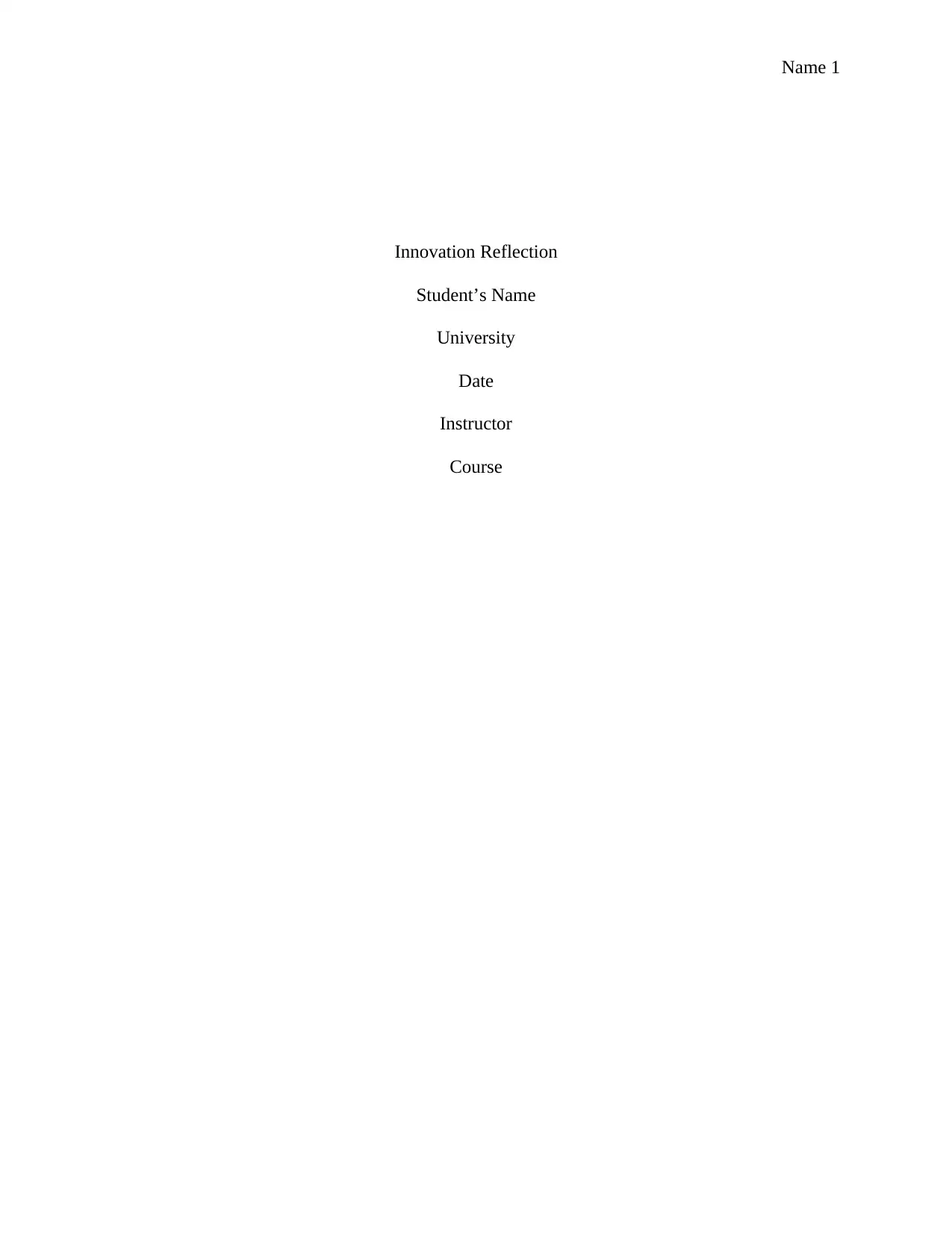
Name 1
Innovation Reflection
Student’s Name
University
Date
Instructor
Course
Innovation Reflection
Student’s Name
University
Date
Instructor
Course
Paraphrase This Document
Need a fresh take? Get an instant paraphrase of this document with our AI Paraphraser
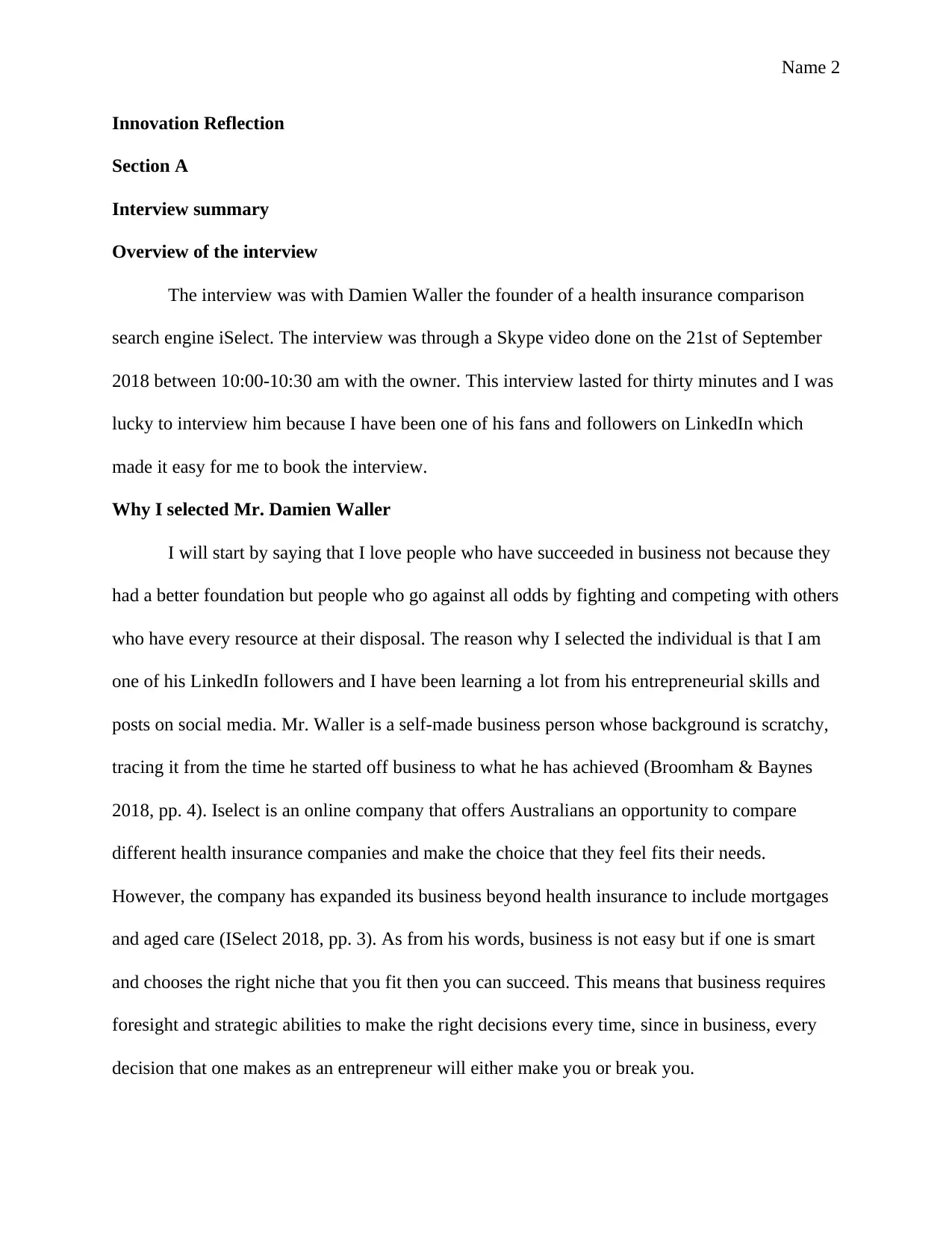
Name 2
Innovation Reflection
Section A
Interview summary
Overview of the interview
The interview was with Damien Waller the founder of a health insurance comparison
search engine iSelect. The interview was through a Skype video done on the 21st of September
2018 between 10:00-10:30 am with the owner. This interview lasted for thirty minutes and I was
lucky to interview him because I have been one of his fans and followers on LinkedIn which
made it easy for me to book the interview.
Why I selected Mr. Damien Waller
I will start by saying that I love people who have succeeded in business not because they
had a better foundation but people who go against all odds by fighting and competing with others
who have every resource at their disposal. The reason why I selected the individual is that I am
one of his LinkedIn followers and I have been learning a lot from his entrepreneurial skills and
posts on social media. Mr. Waller is a self-made business person whose background is scratchy,
tracing it from the time he started off business to what he has achieved (Broomham & Baynes
2018, pp. 4). Iselect is an online company that offers Australians an opportunity to compare
different health insurance companies and make the choice that they feel fits their needs.
However, the company has expanded its business beyond health insurance to include mortgages
and aged care (ISelect 2018, pp. 3). As from his words, business is not easy but if one is smart
and chooses the right niche that you fit then you can succeed. This means that business requires
foresight and strategic abilities to make the right decisions every time, since in business, every
decision that one makes as an entrepreneur will either make you or break you.
Innovation Reflection
Section A
Interview summary
Overview of the interview
The interview was with Damien Waller the founder of a health insurance comparison
search engine iSelect. The interview was through a Skype video done on the 21st of September
2018 between 10:00-10:30 am with the owner. This interview lasted for thirty minutes and I was
lucky to interview him because I have been one of his fans and followers on LinkedIn which
made it easy for me to book the interview.
Why I selected Mr. Damien Waller
I will start by saying that I love people who have succeeded in business not because they
had a better foundation but people who go against all odds by fighting and competing with others
who have every resource at their disposal. The reason why I selected the individual is that I am
one of his LinkedIn followers and I have been learning a lot from his entrepreneurial skills and
posts on social media. Mr. Waller is a self-made business person whose background is scratchy,
tracing it from the time he started off business to what he has achieved (Broomham & Baynes
2018, pp. 4). Iselect is an online company that offers Australians an opportunity to compare
different health insurance companies and make the choice that they feel fits their needs.
However, the company has expanded its business beyond health insurance to include mortgages
and aged care (ISelect 2018, pp. 3). As from his words, business is not easy but if one is smart
and chooses the right niche that you fit then you can succeed. This means that business requires
foresight and strategic abilities to make the right decisions every time, since in business, every
decision that one makes as an entrepreneur will either make you or break you.
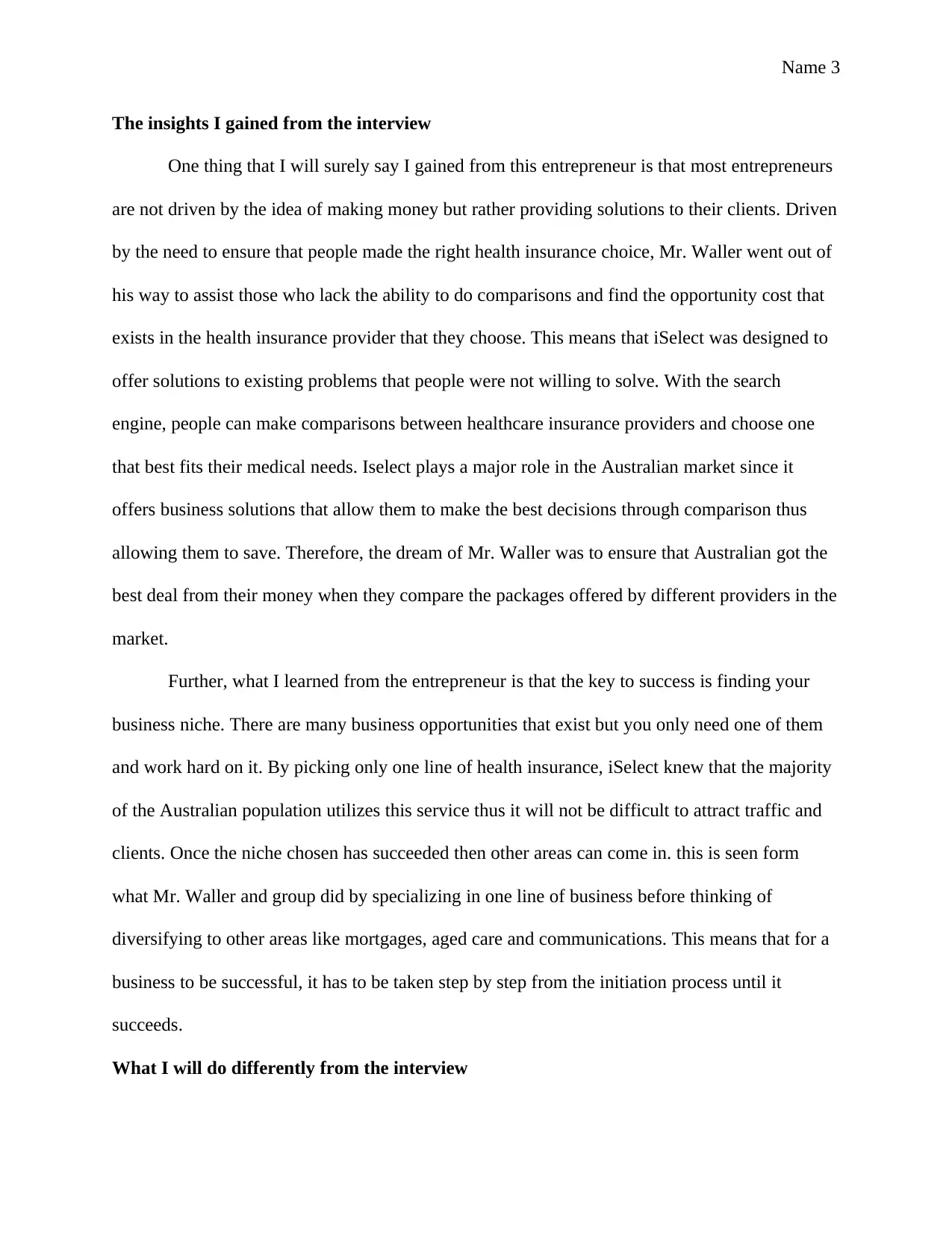
Name 3
The insights I gained from the interview
One thing that I will surely say I gained from this entrepreneur is that most entrepreneurs
are not driven by the idea of making money but rather providing solutions to their clients. Driven
by the need to ensure that people made the right health insurance choice, Mr. Waller went out of
his way to assist those who lack the ability to do comparisons and find the opportunity cost that
exists in the health insurance provider that they choose. This means that iSelect was designed to
offer solutions to existing problems that people were not willing to solve. With the search
engine, people can make comparisons between healthcare insurance providers and choose one
that best fits their medical needs. Iselect plays a major role in the Australian market since it
offers business solutions that allow them to make the best decisions through comparison thus
allowing them to save. Therefore, the dream of Mr. Waller was to ensure that Australian got the
best deal from their money when they compare the packages offered by different providers in the
market.
Further, what I learned from the entrepreneur is that the key to success is finding your
business niche. There are many business opportunities that exist but you only need one of them
and work hard on it. By picking only one line of health insurance, iSelect knew that the majority
of the Australian population utilizes this service thus it will not be difficult to attract traffic and
clients. Once the niche chosen has succeeded then other areas can come in. this is seen form
what Mr. Waller and group did by specializing in one line of business before thinking of
diversifying to other areas like mortgages, aged care and communications. This means that for a
business to be successful, it has to be taken step by step from the initiation process until it
succeeds.
What I will do differently from the interview
The insights I gained from the interview
One thing that I will surely say I gained from this entrepreneur is that most entrepreneurs
are not driven by the idea of making money but rather providing solutions to their clients. Driven
by the need to ensure that people made the right health insurance choice, Mr. Waller went out of
his way to assist those who lack the ability to do comparisons and find the opportunity cost that
exists in the health insurance provider that they choose. This means that iSelect was designed to
offer solutions to existing problems that people were not willing to solve. With the search
engine, people can make comparisons between healthcare insurance providers and choose one
that best fits their medical needs. Iselect plays a major role in the Australian market since it
offers business solutions that allow them to make the best decisions through comparison thus
allowing them to save. Therefore, the dream of Mr. Waller was to ensure that Australian got the
best deal from their money when they compare the packages offered by different providers in the
market.
Further, what I learned from the entrepreneur is that the key to success is finding your
business niche. There are many business opportunities that exist but you only need one of them
and work hard on it. By picking only one line of health insurance, iSelect knew that the majority
of the Australian population utilizes this service thus it will not be difficult to attract traffic and
clients. Once the niche chosen has succeeded then other areas can come in. this is seen form
what Mr. Waller and group did by specializing in one line of business before thinking of
diversifying to other areas like mortgages, aged care and communications. This means that for a
business to be successful, it has to be taken step by step from the initiation process until it
succeeds.
What I will do differently from the interview
⊘ This is a preview!⊘
Do you want full access?
Subscribe today to unlock all pages.

Trusted by 1+ million students worldwide
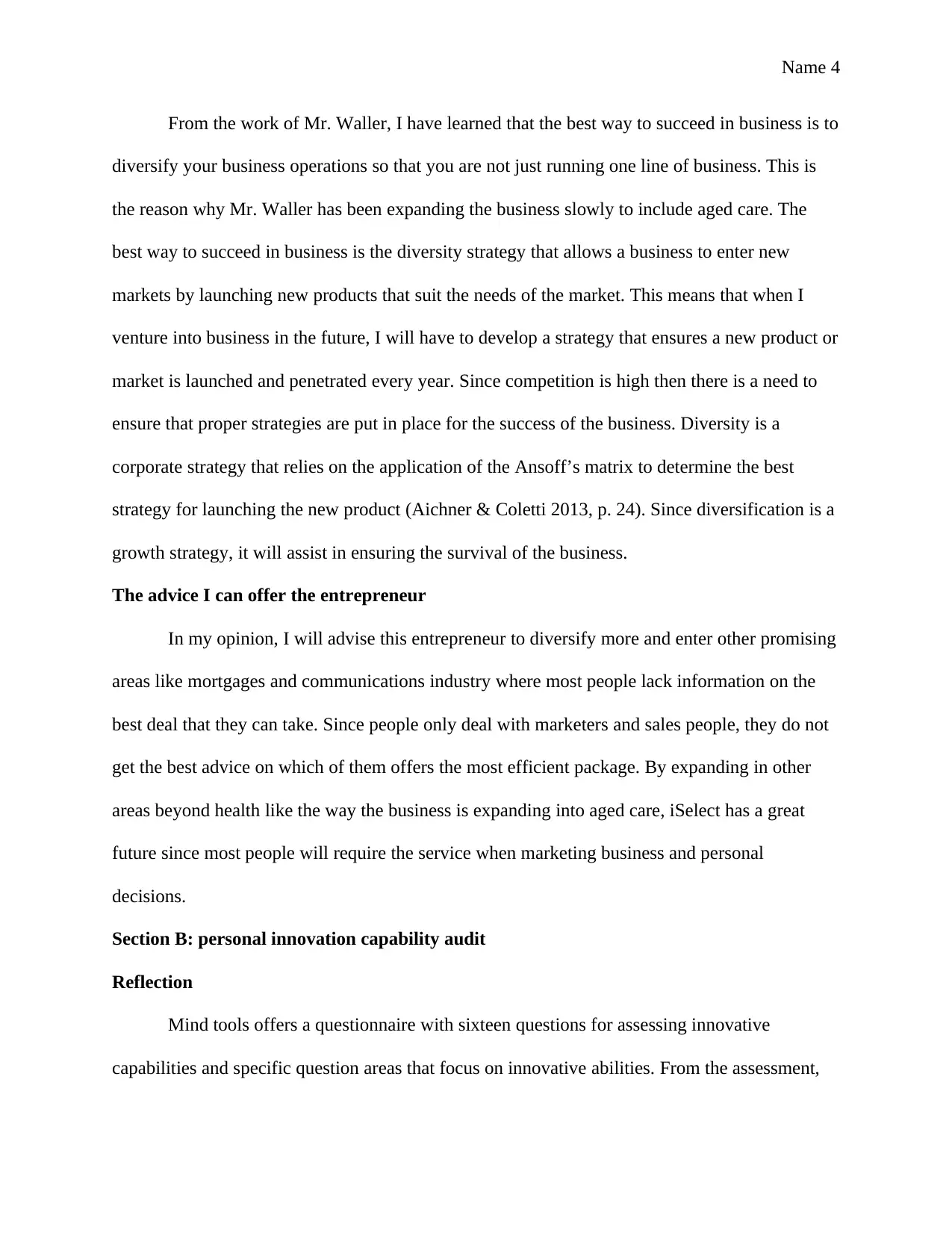
Name 4
From the work of Mr. Waller, I have learned that the best way to succeed in business is to
diversify your business operations so that you are not just running one line of business. This is
the reason why Mr. Waller has been expanding the business slowly to include aged care. The
best way to succeed in business is the diversity strategy that allows a business to enter new
markets by launching new products that suit the needs of the market. This means that when I
venture into business in the future, I will have to develop a strategy that ensures a new product or
market is launched and penetrated every year. Since competition is high then there is a need to
ensure that proper strategies are put in place for the success of the business. Diversity is a
corporate strategy that relies on the application of the Ansoff’s matrix to determine the best
strategy for launching the new product (Aichner & Coletti 2013, p. 24). Since diversification is a
growth strategy, it will assist in ensuring the survival of the business.
The advice I can offer the entrepreneur
In my opinion, I will advise this entrepreneur to diversify more and enter other promising
areas like mortgages and communications industry where most people lack information on the
best deal that they can take. Since people only deal with marketers and sales people, they do not
get the best advice on which of them offers the most efficient package. By expanding in other
areas beyond health like the way the business is expanding into aged care, iSelect has a great
future since most people will require the service when marketing business and personal
decisions.
Section B: personal innovation capability audit
Reflection
Mind tools offers a questionnaire with sixteen questions for assessing innovative
capabilities and specific question areas that focus on innovative abilities. From the assessment,
From the work of Mr. Waller, I have learned that the best way to succeed in business is to
diversify your business operations so that you are not just running one line of business. This is
the reason why Mr. Waller has been expanding the business slowly to include aged care. The
best way to succeed in business is the diversity strategy that allows a business to enter new
markets by launching new products that suit the needs of the market. This means that when I
venture into business in the future, I will have to develop a strategy that ensures a new product or
market is launched and penetrated every year. Since competition is high then there is a need to
ensure that proper strategies are put in place for the success of the business. Diversity is a
corporate strategy that relies on the application of the Ansoff’s matrix to determine the best
strategy for launching the new product (Aichner & Coletti 2013, p. 24). Since diversification is a
growth strategy, it will assist in ensuring the survival of the business.
The advice I can offer the entrepreneur
In my opinion, I will advise this entrepreneur to diversify more and enter other promising
areas like mortgages and communications industry where most people lack information on the
best deal that they can take. Since people only deal with marketers and sales people, they do not
get the best advice on which of them offers the most efficient package. By expanding in other
areas beyond health like the way the business is expanding into aged care, iSelect has a great
future since most people will require the service when marketing business and personal
decisions.
Section B: personal innovation capability audit
Reflection
Mind tools offers a questionnaire with sixteen questions for assessing innovative
capabilities and specific question areas that focus on innovative abilities. From the assessment,
Paraphrase This Document
Need a fresh take? Get an instant paraphrase of this document with our AI Paraphraser
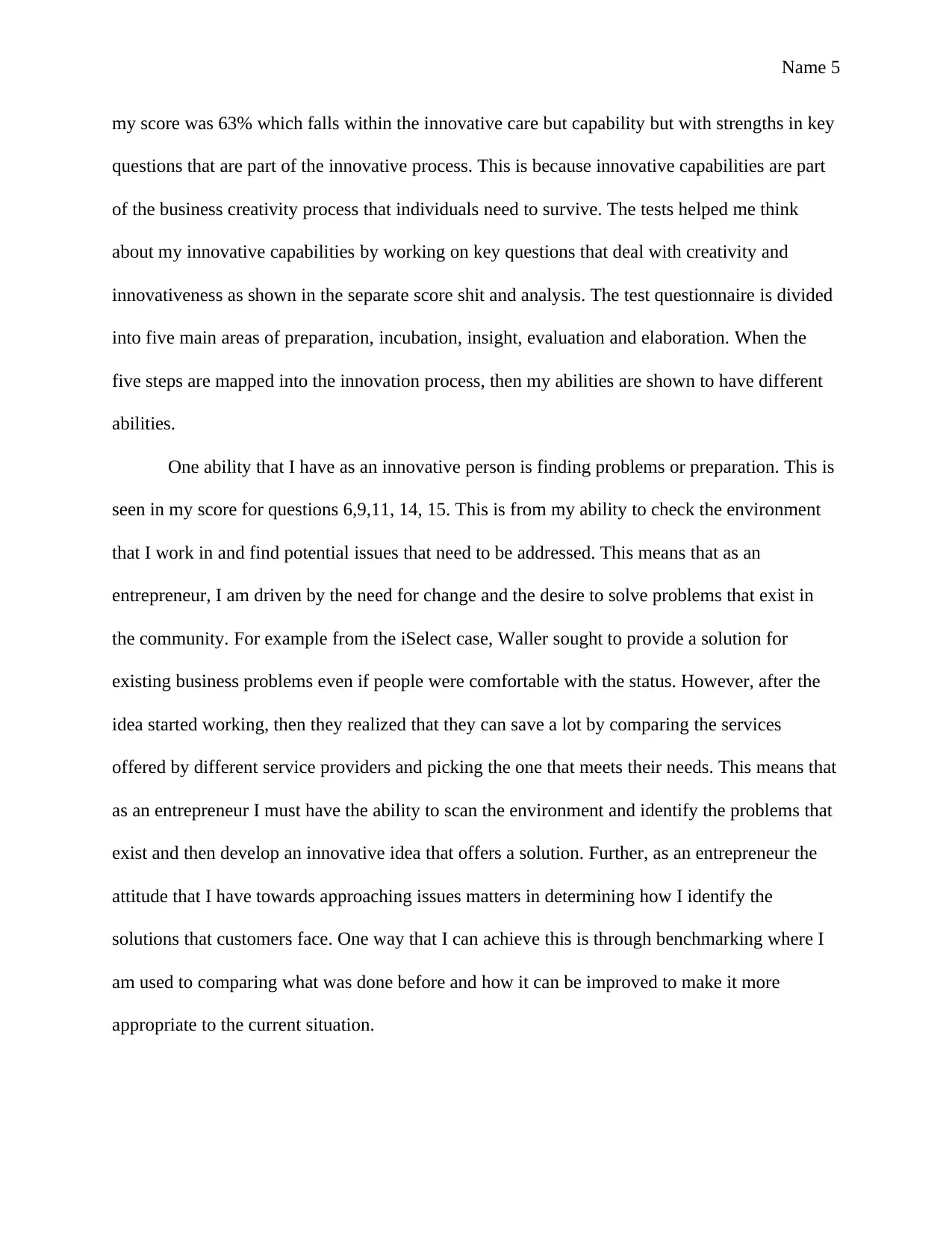
Name 5
my score was 63% which falls within the innovative care but capability but with strengths in key
questions that are part of the innovative process. This is because innovative capabilities are part
of the business creativity process that individuals need to survive. The tests helped me think
about my innovative capabilities by working on key questions that deal with creativity and
innovativeness as shown in the separate score shit and analysis. The test questionnaire is divided
into five main areas of preparation, incubation, insight, evaluation and elaboration. When the
five steps are mapped into the innovation process, then my abilities are shown to have different
abilities.
One ability that I have as an innovative person is finding problems or preparation. This is
seen in my score for questions 6,9,11, 14, 15. This is from my ability to check the environment
that I work in and find potential issues that need to be addressed. This means that as an
entrepreneur, I am driven by the need for change and the desire to solve problems that exist in
the community. For example from the iSelect case, Waller sought to provide a solution for
existing business problems even if people were comfortable with the status. However, after the
idea started working, then they realized that they can save a lot by comparing the services
offered by different service providers and picking the one that meets their needs. This means that
as an entrepreneur I must have the ability to scan the environment and identify the problems that
exist and then develop an innovative idea that offers a solution. Further, as an entrepreneur the
attitude that I have towards approaching issues matters in determining how I identify the
solutions that customers face. One way that I can achieve this is through benchmarking where I
am used to comparing what was done before and how it can be improved to make it more
appropriate to the current situation.
my score was 63% which falls within the innovative care but capability but with strengths in key
questions that are part of the innovative process. This is because innovative capabilities are part
of the business creativity process that individuals need to survive. The tests helped me think
about my innovative capabilities by working on key questions that deal with creativity and
innovativeness as shown in the separate score shit and analysis. The test questionnaire is divided
into five main areas of preparation, incubation, insight, evaluation and elaboration. When the
five steps are mapped into the innovation process, then my abilities are shown to have different
abilities.
One ability that I have as an innovative person is finding problems or preparation. This is
seen in my score for questions 6,9,11, 14, 15. This is from my ability to check the environment
that I work in and find potential issues that need to be addressed. This means that as an
entrepreneur, I am driven by the need for change and the desire to solve problems that exist in
the community. For example from the iSelect case, Waller sought to provide a solution for
existing business problems even if people were comfortable with the status. However, after the
idea started working, then they realized that they can save a lot by comparing the services
offered by different service providers and picking the one that meets their needs. This means that
as an entrepreneur I must have the ability to scan the environment and identify the problems that
exist and then develop an innovative idea that offers a solution. Further, as an entrepreneur the
attitude that I have towards approaching issues matters in determining how I identify the
solutions that customers face. One way that I can achieve this is through benchmarking where I
am used to comparing what was done before and how it can be improved to make it more
appropriate to the current situation.
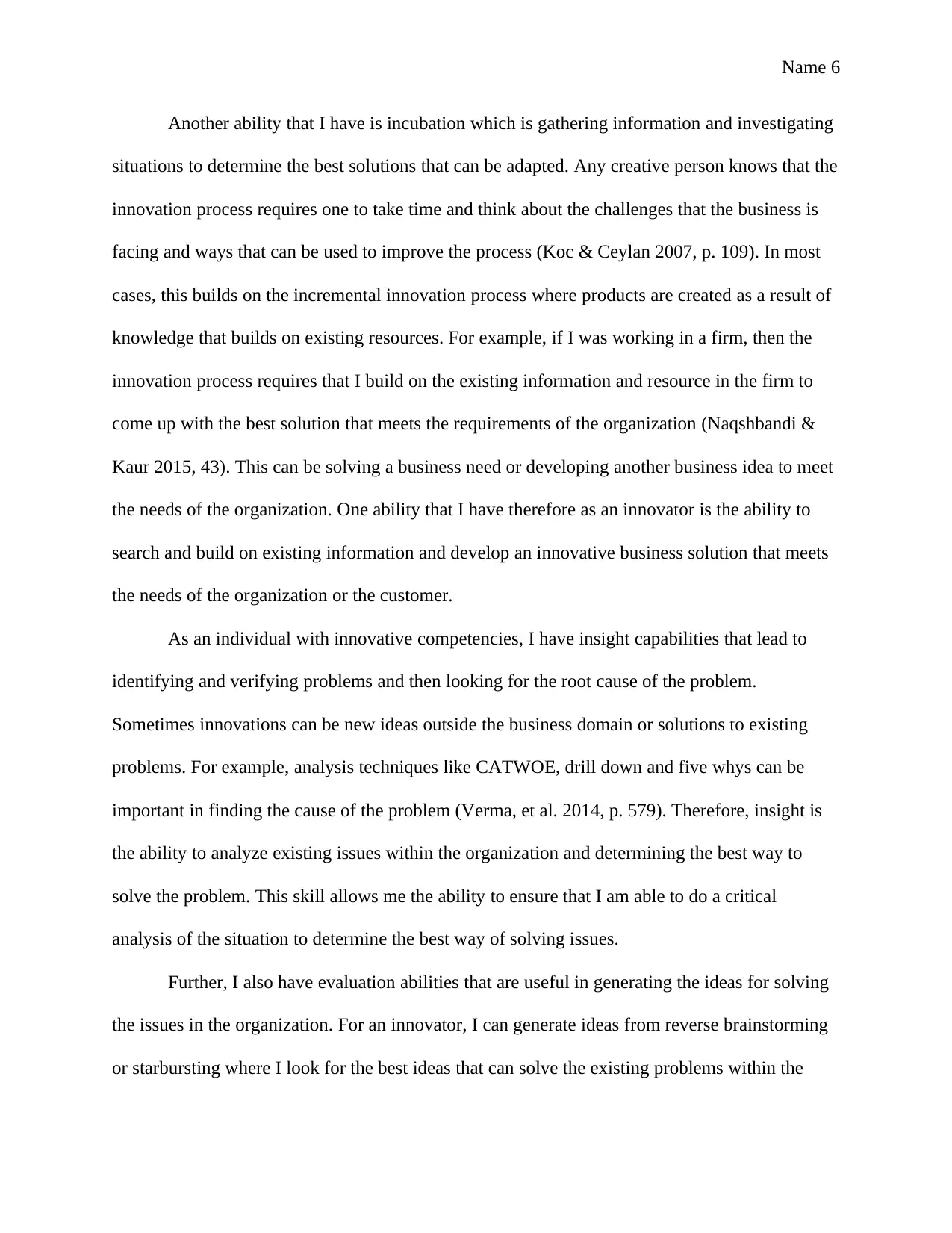
Name 6
Another ability that I have is incubation which is gathering information and investigating
situations to determine the best solutions that can be adapted. Any creative person knows that the
innovation process requires one to take time and think about the challenges that the business is
facing and ways that can be used to improve the process (Koc & Ceylan 2007, p. 109). In most
cases, this builds on the incremental innovation process where products are created as a result of
knowledge that builds on existing resources. For example, if I was working in a firm, then the
innovation process requires that I build on the existing information and resource in the firm to
come up with the best solution that meets the requirements of the organization (Naqshbandi &
Kaur 2015, 43). This can be solving a business need or developing another business idea to meet
the needs of the organization. One ability that I have therefore as an innovator is the ability to
search and build on existing information and develop an innovative business solution that meets
the needs of the organization or the customer.
As an individual with innovative competencies, I have insight capabilities that lead to
identifying and verifying problems and then looking for the root cause of the problem.
Sometimes innovations can be new ideas outside the business domain or solutions to existing
problems. For example, analysis techniques like CATWOE, drill down and five whys can be
important in finding the cause of the problem (Verma, et al. 2014, p. 579). Therefore, insight is
the ability to analyze existing issues within the organization and determining the best way to
solve the problem. This skill allows me the ability to ensure that I am able to do a critical
analysis of the situation to determine the best way of solving issues.
Further, I also have evaluation abilities that are useful in generating the ideas for solving
the issues in the organization. For an innovator, I can generate ideas from reverse brainstorming
or starbursting where I look for the best ideas that can solve the existing problems within the
Another ability that I have is incubation which is gathering information and investigating
situations to determine the best solutions that can be adapted. Any creative person knows that the
innovation process requires one to take time and think about the challenges that the business is
facing and ways that can be used to improve the process (Koc & Ceylan 2007, p. 109). In most
cases, this builds on the incremental innovation process where products are created as a result of
knowledge that builds on existing resources. For example, if I was working in a firm, then the
innovation process requires that I build on the existing information and resource in the firm to
come up with the best solution that meets the requirements of the organization (Naqshbandi &
Kaur 2015, 43). This can be solving a business need or developing another business idea to meet
the needs of the organization. One ability that I have therefore as an innovator is the ability to
search and build on existing information and develop an innovative business solution that meets
the needs of the organization or the customer.
As an individual with innovative competencies, I have insight capabilities that lead to
identifying and verifying problems and then looking for the root cause of the problem.
Sometimes innovations can be new ideas outside the business domain or solutions to existing
problems. For example, analysis techniques like CATWOE, drill down and five whys can be
important in finding the cause of the problem (Verma, et al. 2014, p. 579). Therefore, insight is
the ability to analyze existing issues within the organization and determining the best way to
solve the problem. This skill allows me the ability to ensure that I am able to do a critical
analysis of the situation to determine the best way of solving issues.
Further, I also have evaluation abilities that are useful in generating the ideas for solving
the issues in the organization. For an innovator, I can generate ideas from reverse brainstorming
or starbursting where I look for the best ideas that can solve the existing problems within the
⊘ This is a preview!⊘
Do you want full access?
Subscribe today to unlock all pages.

Trusted by 1+ million students worldwide
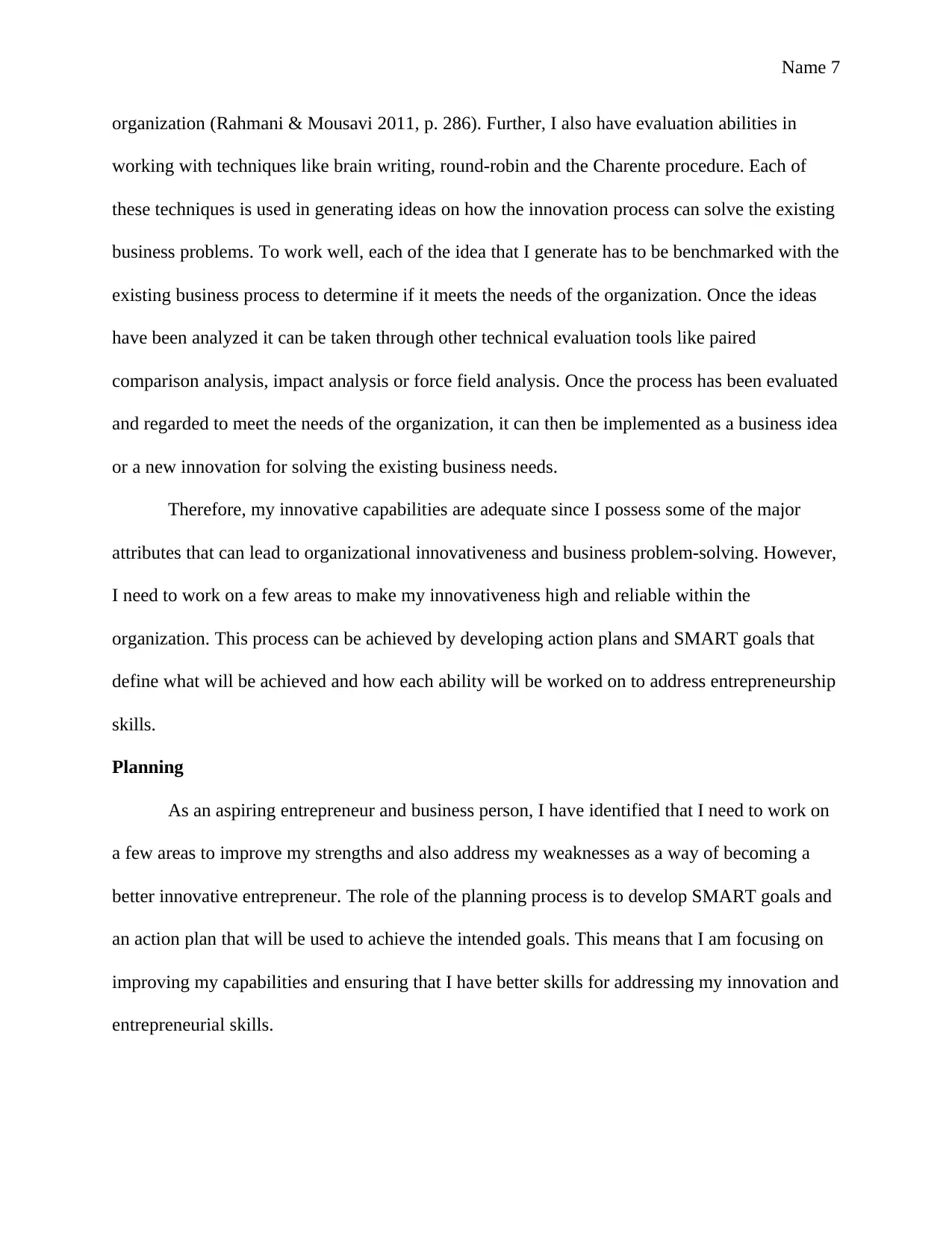
Name 7
organization (Rahmani & Mousavi 2011, p. 286). Further, I also have evaluation abilities in
working with techniques like brain writing, round-robin and the Charente procedure. Each of
these techniques is used in generating ideas on how the innovation process can solve the existing
business problems. To work well, each of the idea that I generate has to be benchmarked with the
existing business process to determine if it meets the needs of the organization. Once the ideas
have been analyzed it can be taken through other technical evaluation tools like paired
comparison analysis, impact analysis or force field analysis. Once the process has been evaluated
and regarded to meet the needs of the organization, it can then be implemented as a business idea
or a new innovation for solving the existing business needs.
Therefore, my innovative capabilities are adequate since I possess some of the major
attributes that can lead to organizational innovativeness and business problem-solving. However,
I need to work on a few areas to make my innovativeness high and reliable within the
organization. This process can be achieved by developing action plans and SMART goals that
define what will be achieved and how each ability will be worked on to address entrepreneurship
skills.
Planning
As an aspiring entrepreneur and business person, I have identified that I need to work on
a few areas to improve my strengths and also address my weaknesses as a way of becoming a
better innovative entrepreneur. The role of the planning process is to develop SMART goals and
an action plan that will be used to achieve the intended goals. This means that I am focusing on
improving my capabilities and ensuring that I have better skills for addressing my innovation and
entrepreneurial skills.
organization (Rahmani & Mousavi 2011, p. 286). Further, I also have evaluation abilities in
working with techniques like brain writing, round-robin and the Charente procedure. Each of
these techniques is used in generating ideas on how the innovation process can solve the existing
business problems. To work well, each of the idea that I generate has to be benchmarked with the
existing business process to determine if it meets the needs of the organization. Once the ideas
have been analyzed it can be taken through other technical evaluation tools like paired
comparison analysis, impact analysis or force field analysis. Once the process has been evaluated
and regarded to meet the needs of the organization, it can then be implemented as a business idea
or a new innovation for solving the existing business needs.
Therefore, my innovative capabilities are adequate since I possess some of the major
attributes that can lead to organizational innovativeness and business problem-solving. However,
I need to work on a few areas to make my innovativeness high and reliable within the
organization. This process can be achieved by developing action plans and SMART goals that
define what will be achieved and how each ability will be worked on to address entrepreneurship
skills.
Planning
As an aspiring entrepreneur and business person, I have identified that I need to work on
a few areas to improve my strengths and also address my weaknesses as a way of becoming a
better innovative entrepreneur. The role of the planning process is to develop SMART goals and
an action plan that will be used to achieve the intended goals. This means that I am focusing on
improving my capabilities and ensuring that I have better skills for addressing my innovation and
entrepreneurial skills.
Paraphrase This Document
Need a fresh take? Get an instant paraphrase of this document with our AI Paraphraser
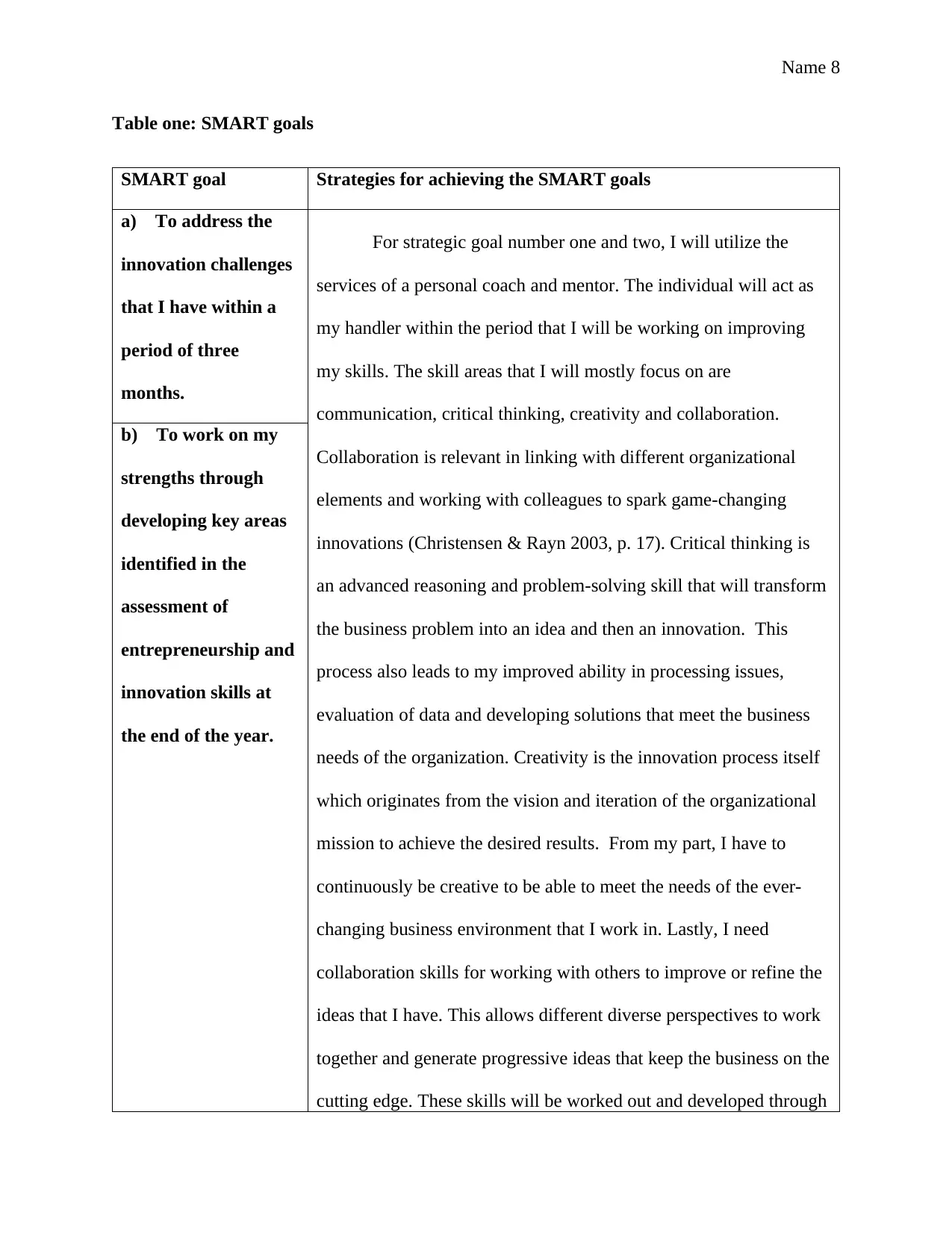
Name 8
Table one: SMART goals
SMART goal Strategies for achieving the SMART goals
a) To address the
innovation challenges
that I have within a
period of three
months.
For strategic goal number one and two, I will utilize the
services of a personal coach and mentor. The individual will act as
my handler within the period that I will be working on improving
my skills. The skill areas that I will mostly focus on are
communication, critical thinking, creativity and collaboration.
Collaboration is relevant in linking with different organizational
elements and working with colleagues to spark game-changing
innovations (Christensen & Rayn 2003, p. 17). Critical thinking is
an advanced reasoning and problem-solving skill that will transform
the business problem into an idea and then an innovation. This
process also leads to my improved ability in processing issues,
evaluation of data and developing solutions that meet the business
needs of the organization. Creativity is the innovation process itself
which originates from the vision and iteration of the organizational
mission to achieve the desired results. From my part, I have to
continuously be creative to be able to meet the needs of the ever-
changing business environment that I work in. Lastly, I need
collaboration skills for working with others to improve or refine the
ideas that I have. This allows different diverse perspectives to work
together and generate progressive ideas that keep the business on the
cutting edge. These skills will be worked out and developed through
b) To work on my
strengths through
developing key areas
identified in the
assessment of
entrepreneurship and
innovation skills at
the end of the year.
Table one: SMART goals
SMART goal Strategies for achieving the SMART goals
a) To address the
innovation challenges
that I have within a
period of three
months.
For strategic goal number one and two, I will utilize the
services of a personal coach and mentor. The individual will act as
my handler within the period that I will be working on improving
my skills. The skill areas that I will mostly focus on are
communication, critical thinking, creativity and collaboration.
Collaboration is relevant in linking with different organizational
elements and working with colleagues to spark game-changing
innovations (Christensen & Rayn 2003, p. 17). Critical thinking is
an advanced reasoning and problem-solving skill that will transform
the business problem into an idea and then an innovation. This
process also leads to my improved ability in processing issues,
evaluation of data and developing solutions that meet the business
needs of the organization. Creativity is the innovation process itself
which originates from the vision and iteration of the organizational
mission to achieve the desired results. From my part, I have to
continuously be creative to be able to meet the needs of the ever-
changing business environment that I work in. Lastly, I need
collaboration skills for working with others to improve or refine the
ideas that I have. This allows different diverse perspectives to work
together and generate progressive ideas that keep the business on the
cutting edge. These skills will be worked out and developed through
b) To work on my
strengths through
developing key areas
identified in the
assessment of
entrepreneurship and
innovation skills at
the end of the year.
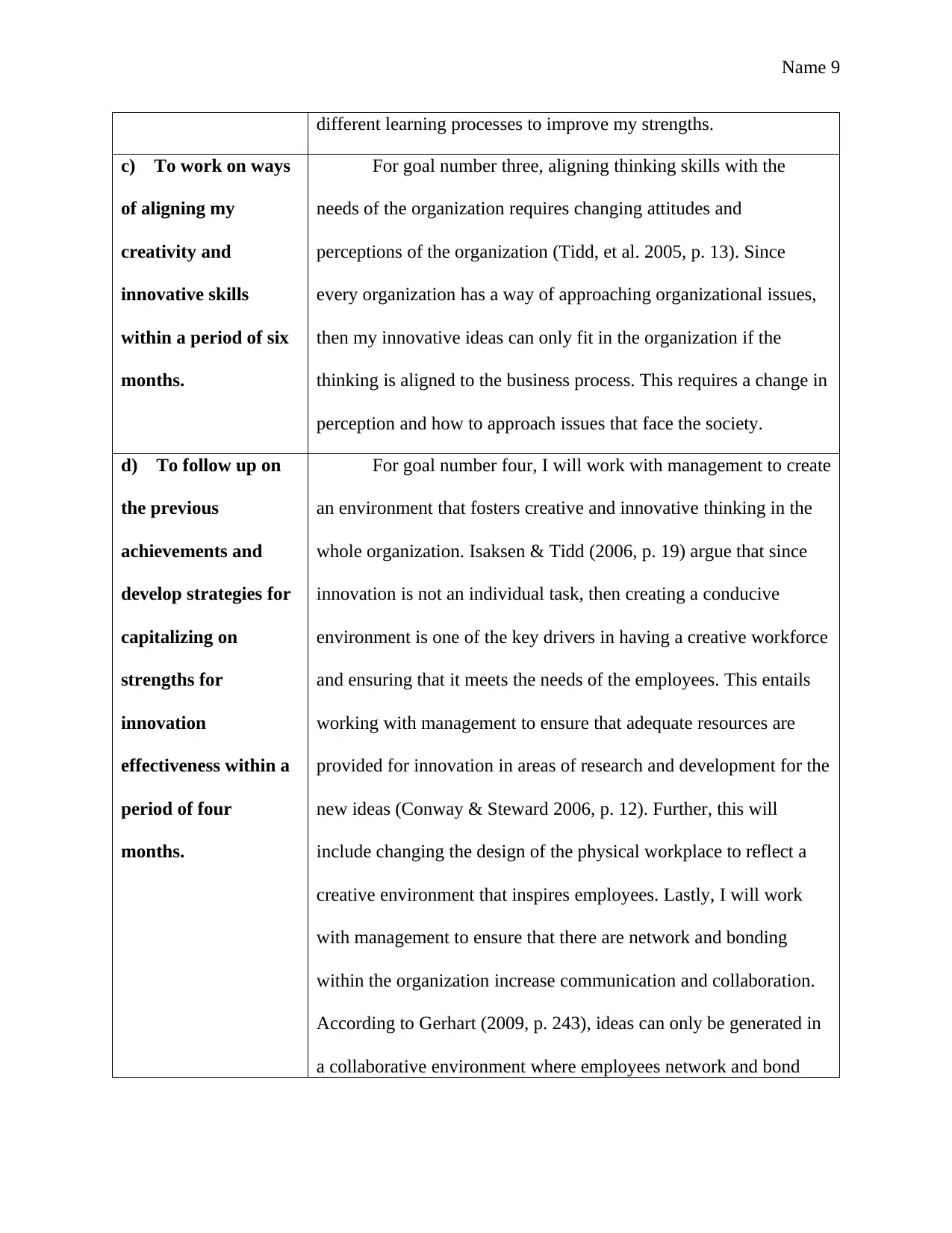
Name 9
different learning processes to improve my strengths.
c) To work on ways
of aligning my
creativity and
innovative skills
within a period of six
months.
For goal number three, aligning thinking skills with the
needs of the organization requires changing attitudes and
perceptions of the organization (Tidd, et al. 2005, p. 13). Since
every organization has a way of approaching organizational issues,
then my innovative ideas can only fit in the organization if the
thinking is aligned to the business process. This requires a change in
perception and how to approach issues that face the society.
d) To follow up on
the previous
achievements and
develop strategies for
capitalizing on
strengths for
innovation
effectiveness within a
period of four
months.
For goal number four, I will work with management to create
an environment that fosters creative and innovative thinking in the
whole organization. Isaksen & Tidd (2006, p. 19) argue that since
innovation is not an individual task, then creating a conducive
environment is one of the key drivers in having a creative workforce
and ensuring that it meets the needs of the employees. This entails
working with management to ensure that adequate resources are
provided for innovation in areas of research and development for the
new ideas (Conway & Steward 2006, p. 12). Further, this will
include changing the design of the physical workplace to reflect a
creative environment that inspires employees. Lastly, I will work
with management to ensure that there are network and bonding
within the organization increase communication and collaboration.
According to Gerhart (2009, p. 243), ideas can only be generated in
a collaborative environment where employees network and bond
different learning processes to improve my strengths.
c) To work on ways
of aligning my
creativity and
innovative skills
within a period of six
months.
For goal number three, aligning thinking skills with the
needs of the organization requires changing attitudes and
perceptions of the organization (Tidd, et al. 2005, p. 13). Since
every organization has a way of approaching organizational issues,
then my innovative ideas can only fit in the organization if the
thinking is aligned to the business process. This requires a change in
perception and how to approach issues that face the society.
d) To follow up on
the previous
achievements and
develop strategies for
capitalizing on
strengths for
innovation
effectiveness within a
period of four
months.
For goal number four, I will work with management to create
an environment that fosters creative and innovative thinking in the
whole organization. Isaksen & Tidd (2006, p. 19) argue that since
innovation is not an individual task, then creating a conducive
environment is one of the key drivers in having a creative workforce
and ensuring that it meets the needs of the employees. This entails
working with management to ensure that adequate resources are
provided for innovation in areas of research and development for the
new ideas (Conway & Steward 2006, p. 12). Further, this will
include changing the design of the physical workplace to reflect a
creative environment that inspires employees. Lastly, I will work
with management to ensure that there are network and bonding
within the organization increase communication and collaboration.
According to Gerhart (2009, p. 243), ideas can only be generated in
a collaborative environment where employees network and bond
⊘ This is a preview!⊘
Do you want full access?
Subscribe today to unlock all pages.

Trusted by 1+ million students worldwide
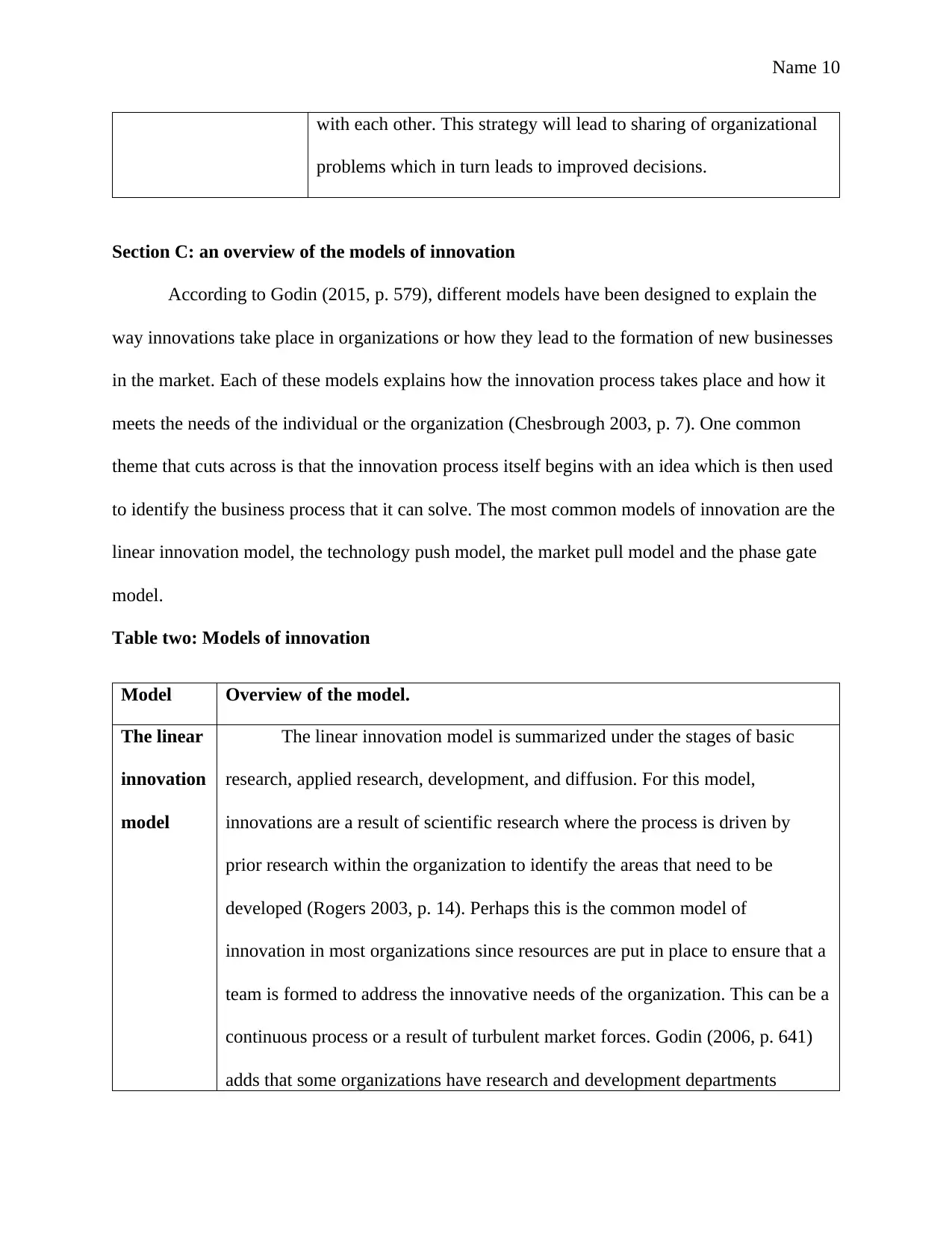
Name 10
with each other. This strategy will lead to sharing of organizational
problems which in turn leads to improved decisions.
Section C: an overview of the models of innovation
According to Godin (2015, p. 579), different models have been designed to explain the
way innovations take place in organizations or how they lead to the formation of new businesses
in the market. Each of these models explains how the innovation process takes place and how it
meets the needs of the individual or the organization (Chesbrough 2003, p. 7). One common
theme that cuts across is that the innovation process itself begins with an idea which is then used
to identify the business process that it can solve. The most common models of innovation are the
linear innovation model, the technology push model, the market pull model and the phase gate
model.
Table two: Models of innovation
Model Overview of the model.
The linear
innovation
model
The linear innovation model is summarized under the stages of basic
research, applied research, development, and diffusion. For this model,
innovations are a result of scientific research where the process is driven by
prior research within the organization to identify the areas that need to be
developed (Rogers 2003, p. 14). Perhaps this is the common model of
innovation in most organizations since resources are put in place to ensure that a
team is formed to address the innovative needs of the organization. This can be a
continuous process or a result of turbulent market forces. Godin (2006, p. 641)
adds that some organizations have research and development departments
with each other. This strategy will lead to sharing of organizational
problems which in turn leads to improved decisions.
Section C: an overview of the models of innovation
According to Godin (2015, p. 579), different models have been designed to explain the
way innovations take place in organizations or how they lead to the formation of new businesses
in the market. Each of these models explains how the innovation process takes place and how it
meets the needs of the individual or the organization (Chesbrough 2003, p. 7). One common
theme that cuts across is that the innovation process itself begins with an idea which is then used
to identify the business process that it can solve. The most common models of innovation are the
linear innovation model, the technology push model, the market pull model and the phase gate
model.
Table two: Models of innovation
Model Overview of the model.
The linear
innovation
model
The linear innovation model is summarized under the stages of basic
research, applied research, development, and diffusion. For this model,
innovations are a result of scientific research where the process is driven by
prior research within the organization to identify the areas that need to be
developed (Rogers 2003, p. 14). Perhaps this is the common model of
innovation in most organizations since resources are put in place to ensure that a
team is formed to address the innovative needs of the organization. This can be a
continuous process or a result of turbulent market forces. Godin (2006, p. 641)
adds that some organizations have research and development departments
Paraphrase This Document
Need a fresh take? Get an instant paraphrase of this document with our AI Paraphraser
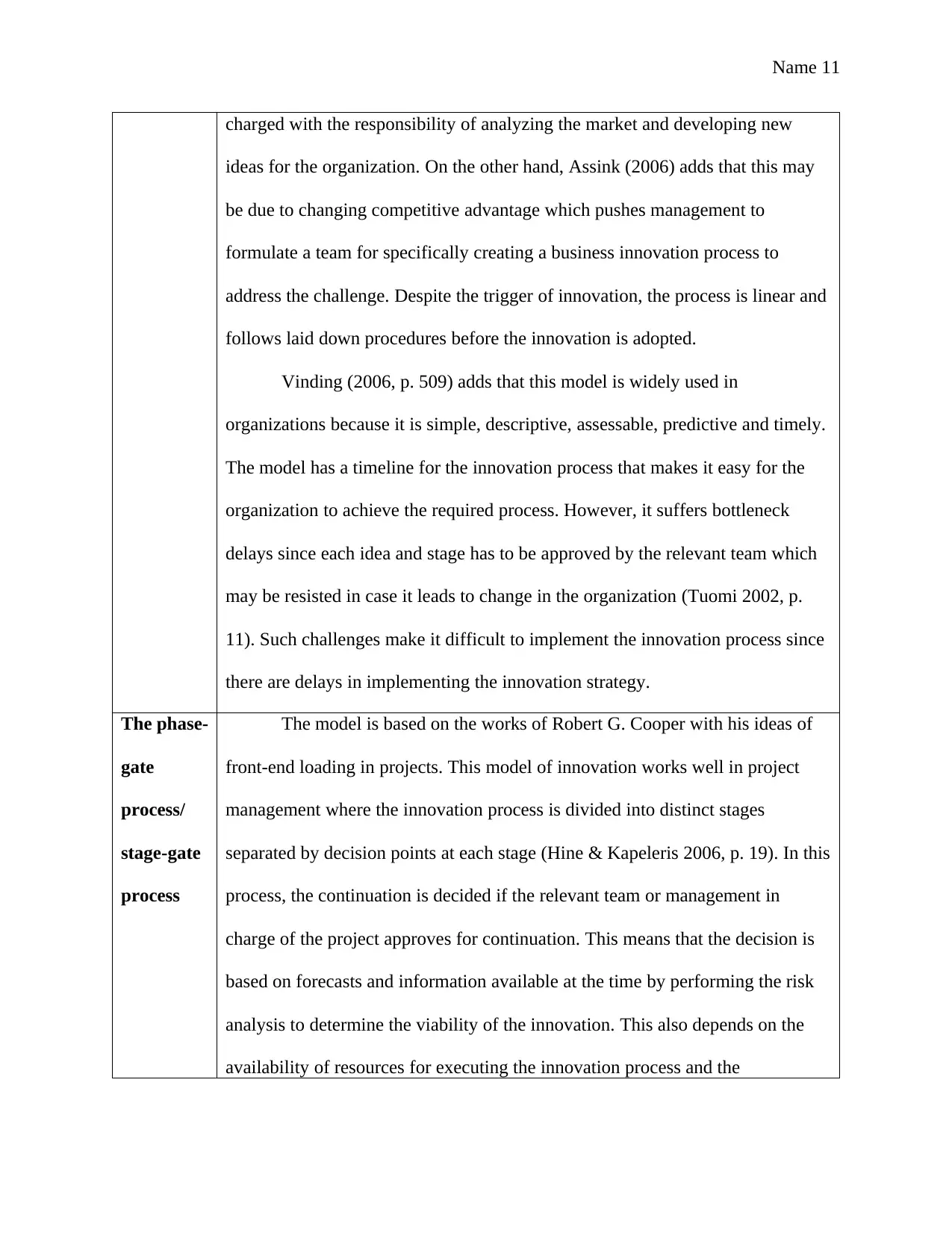
Name 11
charged with the responsibility of analyzing the market and developing new
ideas for the organization. On the other hand, Assink (2006) adds that this may
be due to changing competitive advantage which pushes management to
formulate a team for specifically creating a business innovation process to
address the challenge. Despite the trigger of innovation, the process is linear and
follows laid down procedures before the innovation is adopted.
Vinding (2006, p. 509) adds that this model is widely used in
organizations because it is simple, descriptive, assessable, predictive and timely.
The model has a timeline for the innovation process that makes it easy for the
organization to achieve the required process. However, it suffers bottleneck
delays since each idea and stage has to be approved by the relevant team which
may be resisted in case it leads to change in the organization (Tuomi 2002, p.
11). Such challenges make it difficult to implement the innovation process since
there are delays in implementing the innovation strategy.
The phase-
gate
process/
stage-gate
process
The model is based on the works of Robert G. Cooper with his ideas of
front-end loading in projects. This model of innovation works well in project
management where the innovation process is divided into distinct stages
separated by decision points at each stage (Hine & Kapeleris 2006, p. 19). In this
process, the continuation is decided if the relevant team or management in
charge of the project approves for continuation. This means that the decision is
based on forecasts and information available at the time by performing the risk
analysis to determine the viability of the innovation. This also depends on the
availability of resources for executing the innovation process and the
charged with the responsibility of analyzing the market and developing new
ideas for the organization. On the other hand, Assink (2006) adds that this may
be due to changing competitive advantage which pushes management to
formulate a team for specifically creating a business innovation process to
address the challenge. Despite the trigger of innovation, the process is linear and
follows laid down procedures before the innovation is adopted.
Vinding (2006, p. 509) adds that this model is widely used in
organizations because it is simple, descriptive, assessable, predictive and timely.
The model has a timeline for the innovation process that makes it easy for the
organization to achieve the required process. However, it suffers bottleneck
delays since each idea and stage has to be approved by the relevant team which
may be resisted in case it leads to change in the organization (Tuomi 2002, p.
11). Such challenges make it difficult to implement the innovation process since
there are delays in implementing the innovation strategy.
The phase-
gate
process/
stage-gate
process
The model is based on the works of Robert G. Cooper with his ideas of
front-end loading in projects. This model of innovation works well in project
management where the innovation process is divided into distinct stages
separated by decision points at each stage (Hine & Kapeleris 2006, p. 19). In this
process, the continuation is decided if the relevant team or management in
charge of the project approves for continuation. This means that the decision is
based on forecasts and information available at the time by performing the risk
analysis to determine the viability of the innovation. This also depends on the
availability of resources for executing the innovation process and the
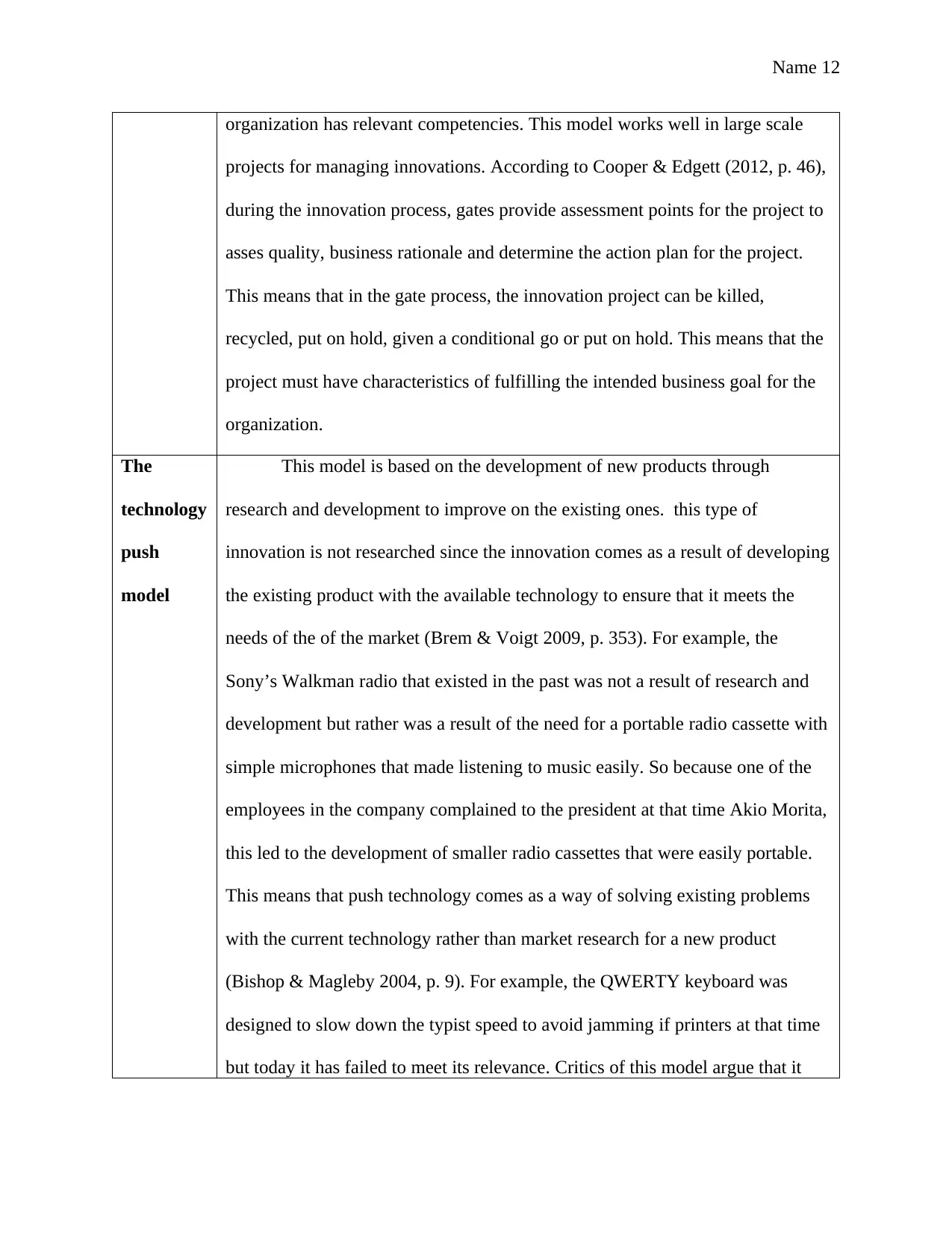
Name 12
organization has relevant competencies. This model works well in large scale
projects for managing innovations. According to Cooper & Edgett (2012, p. 46),
during the innovation process, gates provide assessment points for the project to
asses quality, business rationale and determine the action plan for the project.
This means that in the gate process, the innovation project can be killed,
recycled, put on hold, given a conditional go or put on hold. This means that the
project must have characteristics of fulfilling the intended business goal for the
organization.
The
technology
push
model
This model is based on the development of new products through
research and development to improve on the existing ones. this type of
innovation is not researched since the innovation comes as a result of developing
the existing product with the available technology to ensure that it meets the
needs of the of the market (Brem & Voigt 2009, p. 353). For example, the
Sony’s Walkman radio that existed in the past was not a result of research and
development but rather was a result of the need for a portable radio cassette with
simple microphones that made listening to music easily. So because one of the
employees in the company complained to the president at that time Akio Morita,
this led to the development of smaller radio cassettes that were easily portable.
This means that push technology comes as a way of solving existing problems
with the current technology rather than market research for a new product
(Bishop & Magleby 2004, p. 9). For example, the QWERTY keyboard was
designed to slow down the typist speed to avoid jamming if printers at that time
but today it has failed to meet its relevance. Critics of this model argue that it
organization has relevant competencies. This model works well in large scale
projects for managing innovations. According to Cooper & Edgett (2012, p. 46),
during the innovation process, gates provide assessment points for the project to
asses quality, business rationale and determine the action plan for the project.
This means that in the gate process, the innovation project can be killed,
recycled, put on hold, given a conditional go or put on hold. This means that the
project must have characteristics of fulfilling the intended business goal for the
organization.
The
technology
push
model
This model is based on the development of new products through
research and development to improve on the existing ones. this type of
innovation is not researched since the innovation comes as a result of developing
the existing product with the available technology to ensure that it meets the
needs of the of the market (Brem & Voigt 2009, p. 353). For example, the
Sony’s Walkman radio that existed in the past was not a result of research and
development but rather was a result of the need for a portable radio cassette with
simple microphones that made listening to music easily. So because one of the
employees in the company complained to the president at that time Akio Morita,
this led to the development of smaller radio cassettes that were easily portable.
This means that push technology comes as a way of solving existing problems
with the current technology rather than market research for a new product
(Bishop & Magleby 2004, p. 9). For example, the QWERTY keyboard was
designed to slow down the typist speed to avoid jamming if printers at that time
but today it has failed to meet its relevance. Critics of this model argue that it
⊘ This is a preview!⊘
Do you want full access?
Subscribe today to unlock all pages.

Trusted by 1+ million students worldwide
1 out of 16
Related Documents
Your All-in-One AI-Powered Toolkit for Academic Success.
+13062052269
info@desklib.com
Available 24*7 on WhatsApp / Email
![[object Object]](/_next/static/media/star-bottom.7253800d.svg)
Unlock your academic potential
Copyright © 2020–2025 A2Z Services. All Rights Reserved. Developed and managed by ZUCOL.




